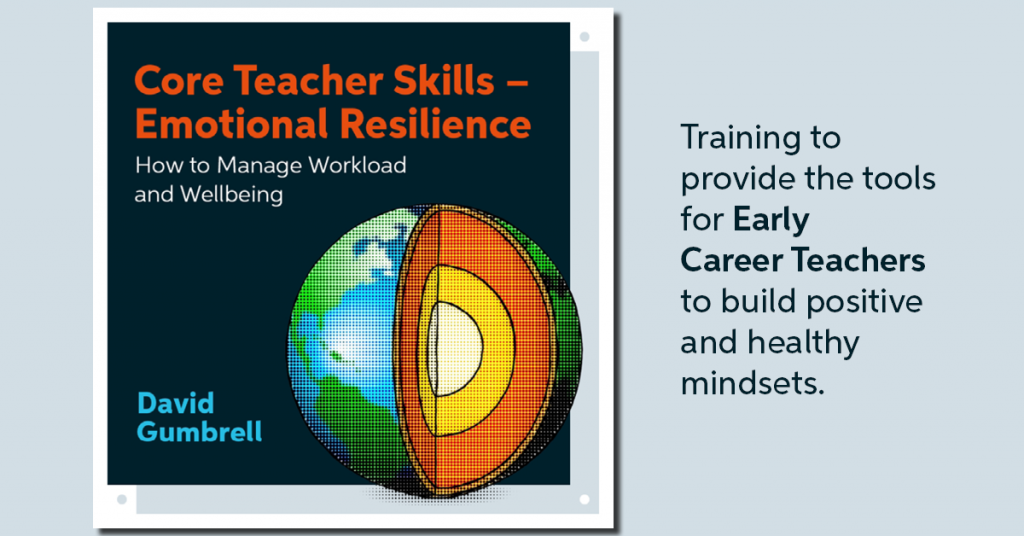
Education Consultant, David Gumbrell has created a 3-episode training course for early career teachers looking to develop their resilience, through tips on improving teacher wellbeing and workload management. Using terminology from the ITT framework, it covers routines, mentors, colleague support and overall wellbeing.
Why did you create this online training?
I created the training as there remains a need to encourage teachers to look after themselves. In order to be the best teacher that they can be, they need to do more to look after themselves – as the saying goes, you can’t pour from an empty cup. However, teachers are resisting this need, thinking that time spent on them is not time well spent . . . yet it is! The training seeks to redress this imbalance and convince colleagues of its importance. It is only when we stop, can we think straight and potentially see the bigger picture. The more strategic overview was what I sometimes missed out on when I was in the classroom. Some days, looking after myself didn’t even appear on my ‘To Do List’ let alone get done. My hope is that the training will encourage you to not fall into this trap. Instead, it can act as a remind of the central importance of maintaining your resilience and teacher wellbeing.
Who is the training for?
The training is applicable to all teachers, although specifically designed for Early Career Teachers, those just setting out into this wonderful profession. It is an attempt to set good teacher wellbeing habits in place early on and so that they can become more sustainable – set out as they mean to go on. Sometimes we are so desperate to impress our new school, we give it everything and more. However, you can only do this for a short space of time – yet, this is a marathon, rather than a sprint. Iteratively, we can develop improvements – take longer movement breaks, stop longer for meals, protect our sleep a bit better each week. These small changes can add up to something quite impressive over time and can make a real difference. There appears to be, at least in some schools that I visit, a peer pressure to ‘do more’, to ‘work on’ rather than to pause. I always felt better and more productive as a teacher if I paused/stopped and took a moment for myself.
What makes it so pertinent for teachers suffering from burnout?
It is important for teachers to manage and deal with their resilience needs proactively, rather than reactively. We shouldn’t need to reach the point of burnout, as we should be alert enough to catch it sooner than that! My thinking is to promote people to look after themselves on a daily basis, rather than waiting for half term and other holidays to do it. Short daily routines will prevent this excessive build up that leads to burnout. A little every day, builds to a lot over time as I said in my previous answer. Many people think that resilience is purely about bouncing back, and in many ways it is. However, bouncing back from a shorter distance will be easier to achieve and quicker to do. Those who look after themselves find themselves able to do it more efficiently and effectively. I know that now, yet I wished that I had known more about the benefits of that when I was in the primary classroom. I know that I was guilty at times of counting down the days to half-term, rather than enjoying the school day that I was currently in! Hopefully a refocus on what is important, you, will allow you to gain that clarity of thinking, that accurate perception that will allow you to justify looking after Number One (safe in the knowledge that your teaching and your pupils benefit too). Try it, you might like it.
Why do you use the Earth as a metaphor throughout?
4) I think that metaphors can be useful as it offers a visual image to hold onto – to make it memorable. In drawing the theme out about the Earth, I hoped to connect the 3-parts to the three main layers of the Earth. The metaphor was also useful for me to seek to explain that at the core of any good teacher, is the looking after themselves. The Earth works around its core and we do too – hopefully I made that clear in the training. Much of my writing uses metaphor for the same purposes – it offers something to ‘hold onto’. In having your curiosity nudged, there is also a possibility that they will then well others. Like a ripple effect, a conversation about resilience and teacher wellbeing (via the metaphor of the Earth) is perpetuated and that can only be a good thing. Too many people, including teachers, still have a stigma attached to talking about mental health. Many still see it as a weakness, rather than a reality of being a human being. I tried to be the ‘superhero’ teacher and came short. I would have been better off with a realistic vision of what is possible on a day-to-day basis.
David Gumbrell conducts training as an Education Consultant and was previously a primary school headteacher. He has been a teacher for 25+ years in 5 different settings; the last setting was as a Headteacher for 7 years. He left to pursue a new career in presenting, writing and coaching NQTs, and works part-time at Kingston University as a Senior Lecturer in Primary Education. He is also the author of The Amazing A-Z of Resilience: 26 Curious Stories and Activities to Lift Yourself Up.